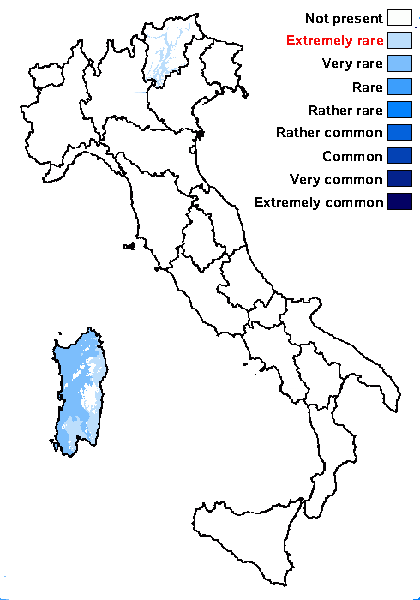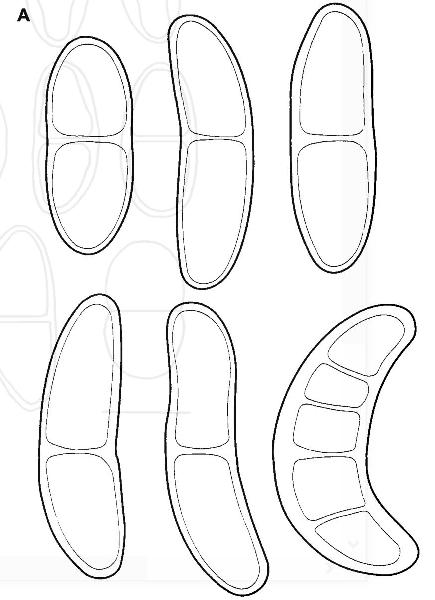Buellia longispora Scheid.
Lichenologist, 25: 352, 1993.
Synonyms:
Distribution: N - TAA (B-180942). C - Sar (Scheidegger 1993).
Description: Thallus crustose, episubstratic, granular to bullate, whitish, delimited by a black prothallus, growing on the thalli of other crustose lichens. Medulla strongly amyloid, I+ blue. Apothecia lecideine, black, 0.5-1 mm across, sessile and constricted at base, with a flat to strongly convex disc and a thin, finally excluded proper margin. Proper exciple Dispersa-type, of radially arranged hyphae, the inner part of long-celled, parallel, strongly agglutinated and thick-walled hyphae, the outer part of short-celled, isodiametric hyphae without intercellular spaces; epithecium brown; hymenium colourless, without oil droplets, c. 85 µm high; hypothecium dark brown. Asci 8-spored, clavate to cylindrical-clavate, the apical dome K/I+ dark blue with a pale, conical-pointed apical cushion (axial mass), the wall I-, but the thin outer gel I+ blue, Bacidia-type. Ascospores 1-3-septate (pluriseptate only when overmature), brown, narrowly oblong, not constricted at septum, 15-30 x 7-10 µm, Buellia-type, with a rugulate ornamentation. Pycnidia black, immersed in thallus. Conidia bacilliform, 5-5.7 µm long. Photobiont chlorococcoid. Spot tests: thallus K+ yellow turning red (with crystals), C-, KC-, P- or P+ faintly yellow. Chemistry: atranorin, norstictic acid with connorstictic acid, stictic acid with cryptostictic, constictic and menegazziaic acids.Note: a mainly Mediterranean species of granitic rocks, also occurring in the Alps in warm-dry situations, often starting the life-cycle on aspicilioid lichens.
Growth form: Crustose
Substrata: rocks
Photobiont: green algae other than Trentepohlia
Reproductive strategy: mainly sexual
Commonnes-rarity: (info)
Alpine belt: absent
Subalpine belt: absent
Oromediterranean belt: absent
Montane belt: absent
Submediterranean belt: extremely rare
Padanian area: absent
Humid submediterranean belt: very rare
Humid mediterranean belt: very rare
Dry mediterranean belt: extremely rare

Predictive model
Growth form: Crustose
Substrata: rocks
Photobiont: green algae other than Trentepohlia
Reproductive strategy: mainly sexual
Commonnes-rarity: (info)
Alpine belt: absent
Subalpine belt: absent
Oromediterranean belt: absent
Montane belt: absent
Submediterranean belt: extremely rare
Padanian area: absent
Humid submediterranean belt: very rare
Humid mediterranean belt: very rare
Dry mediterranean belt: extremely rare

Predictive model
 INDEX FUNGORUM
INDEX FUNGORUM
 GBIF
GBIF
 DOLICHENS
DOLICHENS


